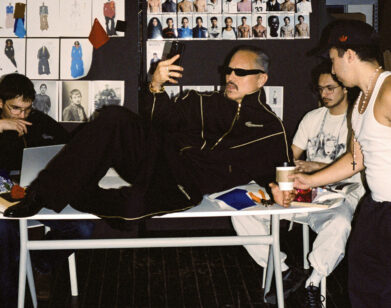FAST FASHION
Who is Brandy Melville?

For millennials who came of age before the one-size-fits-most Abercrombie-esque chain hit American soil in 2009, Brandy Melville is synonymous with tweens and tiny tank tops. For Gen Zs, who grew up watching models like Kaia Gerber hawk the brand’s outfits on Instagram, Brandy’s more like the popular girl who makes high school hell for anyone who doesn’t fit into her clique, or in this case, her clothes. But according to Eva Orner, the award-winning filmmaker behind HBO’s excellent new documentary Brandy Hellville & the Cult of Fast Fashion, the company is actually named after two fictional lovers: Brandy, an American girl, and Melville, an Englishman, conceived of by the brand’s mysterious founder, Stephen Marsan. Much like the Wizard of Oz, the Ayn Rand-loving Italian operates his business anonymously, only his munchkins are teenage girls, hand-selected to work his stores and model his clothing according to their style, size, and race. Orner’s film successfully details how he masterfully uses tired notions of size-exclusivity and white supremacy to manipulate teens into buying childlike clothes, but the despicable man behind the curtain isn’t the only thing we have to worry about when it comes to the rise of fast fashion.
Stephen Marsan isn’t the first evil genius to bank on youth worship, white supremacy, and Americana aesthetics to sell cheaply-produced clothes. But his marketing model differs from that of his predecessors. Unlike previously canceled brands like Abercrombie and American Apparel, which relied on sexy advertisements to sell cotton basics to customers desperate to fit into their corn-fed vision for America, Brandy Melville found success on Instagram, where wistful photographs of impossibly thin teenage girls, often cropped into headless torsos, grabbed a whole new generation of consumers. Instead of advertising, the company sends clothing to would-be influencers, and hires teenage photographers to capture content on store staff members who double as models. In this economy, envy encourages more shopping, and more posts, resulting in an endless trove of user-generated content mined and reshared by the company, and on it goes.
The grift continues amongst twee California surf-inspired decor, where in-store employees are prompted to photograph ostensibly good-looking customers when a red light flares next to the cash register. Throughout Orner’s documentary, this culture of bodily curation and surveillance becomes increasingly disturbing; it’s revealed that employees of color are relegated to stock rooms and anyone deemed too edgy, ugly, or fat is fired instantaneously. These accounts are corroborated by ex-company execs and store owners, some anonymous, who are currently pursuing litigation against Marsan for instances of racial profiling that have previously resulted in store-shutterings and lost earnings. Others are simply absolving their guilt for participating in a cult of myopic marketing schemes facilitated by an executive-level group chat that once included anti-Semitic Hitler memes and the daily body shaming and slandering of teenage girls, the very girls who made their businesses so profitable in the first place.
If that isn’t enough to make you sick, Orner doubles down with anecdotes about one-size-fits-all-induced eating disorders and one particularly harrowing account of a sexual assault of a staff member at a company-owned apartment in New York City. These tales are all interwoven with clips detailing the impact of fast fashion on the environment, the underpaid laborers who produce it, and the workers in the global south who are left to deal with our scraps after we toss out our cheaply produced clothes. In one particularly visceral segment, we visit a clothing market in Ghana, once the biggest slave trading port in Africa, where clips of women transporting 120-pound bundles of clothing on their heads are juxtaposed with b-roll taken at a nearby beach strewn with tentacles made up of branded t-shirts destined to become one with the ocean, it’s fish, and eventually, our food. To summarize the documentary, and a conversation I had with Orner last week: fast fashion is the epitome of evil, and the men behind Brandy Melville, with their unrelenting exploitation of both the environment and the women who nurture it, are fast fashion incarnate, unrepentant for their sins.
If all this seems inauspicious, Brandy Hellville ends with an actionable, inspirational message. If we boycott the company, Orner argues, Marsan and his minions won’t have the finances to carry on; and if we shop less, there won’t be so much waste to deal with. The latter is a no-brainer, particularly at a time when even the revival of vintage shopping bolsters trends and a subsequent desire to consume more and more. Yet when it comes to successfully boycotting Brandy Melville, I’m less convinced. The documentary hinges on reporting found in a 2021 Business Insider exposé by Kate Taylor, who features throughout. Back then, countless media outlets picked up her reporting, resulting in hordes of would-be customers boycotting the brand and even quitting their jobs in-store. But prior to the release of Brandy Hellville, those stories were long forgotten. Just as Marsan is able to cycle through employees at his stores, he’s able to cycle through new generations of consumers, teenagers who aren’t aware of articles circa 2021 but have the means to shop for inexpensive clothing, and the power to influence their friends to do the same.
When I expressed my skepticism to Orner, she rebuffed me. If teen girls are able to influence their friends to buy clothes, she said, they can also influence them to boycott brands—and TikTok, the main vehicle for disseminating such information, is much more ubiquitous now than it was three years ago. As of last week, the trailer for Brandy Hellville already had 2.8 million views, unheard-of numbers for a documentary, and additional ex-employees were already coming forward on social media with their own Brandy Hellville stories. The resulting multimedia exposé might have a lasting impact on the company, but whether that amounts to more than a fast fashion game of Whack-a-Mole is yet to be determined. Last time I googled Brandy Melville, I came across an article hawking Brandy-inspired shopping alternatives in Teen Vogue. Almost all were underpriced Amazon.com dupes, poorly produced, accessibly-sized t-shirts and sweatpants destined to be worn once or twice for a quick mirror selfie, before being donated and eventually shipped off to Ghana, their parts destined to float at sea for eternity.






